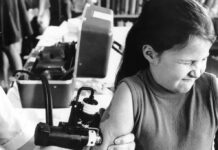(English version below)
Cuando fui al centro de imágenes para mi mamografía habitual el año pasado, la recepcionista me preguntó si me gustaría hacerme una mamografía “3-D” en lugar de la prueba estándar.
“Es más precisa”, me explicó.
¿Qué puedes responder cuando te dicen eso? “¿No, gracias, prefiero tener la prueba que no es precisa?”. Por supuesto, acepté.
Es probable que un número creciente de mujeres se enfrente a una elección similar en los próximos años, a medida que los centros de imágenes de todo el país agregan una mamografía tridimensional (3D), conocida también como tomosíntesis digital del seno, a las opciones para las mujeres que usualmente se hacen una mamografía común, bidimensional.
Lo que aún no está claro es si esta tecnología más nueva y más cara es mejor para detectar el cáncer de seno más mortal. Entonces, ¿debería ser ampliamente recomendada? ¿Y quién debería asumir el costo adicional involucrado?
De acuerdo con la Administración de Alimentos y Medicamentos (FDA), 3,915 instalaciones certificadas de imágenes de mamografías ofrecieron tomosíntesis digital de seno en lo que va de enero. Eso es un fuerte aumento con respecto a enero del año pasado, cuando fueron un total de 3,011.
Algunas instalaciones han cambiado completamente a imágenes tridimensionales, pero muchas tienen ambas, según los expertos.
“Hay mucha presión de marketing para ofrecer estas nuevas máquinas”, dijo Robert Smith, vicepresidente de detección de cáncer en la American Cancer Society.
Ambos tipos de pruebas usan tecnología de rayos X para crear imágenes del seno. Las mamografías digitales bidimensionales -que se realizan en la mayoría de las mujeres- suelen proporcionar imágenes frontales y laterales, mientras que para la prueba 3-D los rayos X se arquean a través del pecho, creando múltiples imágenes del tejido mamario.
Para las mujeres la experiencia es la misma, porque ambas exploraciones implican comprimir el seno entre dos placas.
Los estudios generalmente han demostrado que la prueba 3-D es un poco mejor para detectar el cáncer que la prueba 2-D, y las mujeres generalmente tienen que regresar con menos frecuencia para tener imágenes adicionales. Pero el jurado todavía está deliberando sobre si la tecnología más nueva es mejor para identificar los cánceres avanzados que serán más letales.
“Los cánceres no siempre progresan y matan a las personas”, explicó la doctora Etta Pisano, directora científica del Centro de Investigación e Innovación del Colegio Americano de Radiología y profesora de la Facultad de Medicina de Harvard. Pisano liderará un ensayo clínico de cinco años con 165,000 mujeres que comparará los dos tipos de exámenes de detección para evaluar si la nueva tecnología reduce el riesgo de desarrollar cánceres potencialmente mortales.
“Si la tomosíntesis está mejorando la probabilidad que las mujeres sobrevivan a sus cánceres de seno, debería haber menos cánceres que sean más propensos a matar mujeres entre los 4.5 años desde la evaluación. Como la tomosíntesis los detectó temprano, nunca llegarán a ser cánceres malos”, dijo Pisano.
El sobrediagnóstico es una de las desventajas potenciales de esta tecnología, opinó el doctor David Grossman, presidente del Grupo de Trabajo de Servicios Preventivos de los Estados Unidos. La prueba más sensible detecta más lesiones mamarias cuyo significado clínico no está claro, lo que puede dar lugar a que las mujeres reciban más pruebas y tratamientos que no necesitan. Algunas investigaciones sugieren que la tasa de biopsia es ligeramente más alta con mamografías 3-D.
Bajo la Ley de Cuidado de Salud Asequible (ACA), la mayoría de los planes de salud deben cubrir los servicios preventivos recomendados por el equipo de trabajo sin cobrar a los pacientes nada de su bolsillo. El grupo recomienda mamografías cada dos años para mujeres de 50 a 74 años, pero dice que no hay suficiente evidencia para recomendar mamografías 3-D en este momento.
La cobertura por parte del seguro de pruebas en 3-D ha mejorado en los últimos años, pero no está garantizada. La prueba 3-D generalmente cuesta alrededor de $50 más que una prueba 2-D, según un estudio de 2015 de Truven Health Analytics que fue financiado por Hologic, un fabricante de sistemas de mamografía 3-D. Medicare también cubre pruebas 3-D.
Un número creciente de estados exige que las aseguradoras comerciales cubran mamografías en 3-D, incluidos Arkansas, Texas, Connecticut, Maryland, Illinois y Pennsylvania.
Mi estado, Nueva York, también requiere cobertura, sin ningún costo de bolsillo. Aunque no tuve que pagarlo, la explicación de los beneficios que obtuve de mi aseguradora indica que la porción 3-D de la prueba agregó $51 al costo de $157 de la mamografía.
“Los costos son altos para las nuevas tecnologías”, dijo Pisano. “Tal vez sean mejores, pero necesitamos pruebas antes de recomendarlas a toda la población”.
Entonces, si te ofrecen una prueba 3-D, ¿deberías tenerla?
“Si el examen está disponible sin costo adicional, los datos que tenemos ahora nos dicen que tiene algunas ventajas”, dijo Smith. Por otro lado, “cualquier mujer que se siente estresada por el costo adicional… debería sentirse cómoda haciéndose una mamografía con regularidad”, finalizó.
Esta historia fue producida por Kaiser Health News, un programa editorialmente independiente de la Kaiser Family Foundation
(English version)
When I went to the imaging center for my regular mammogram last year, the woman behind the desk asked me if I’d like to get a “3-D” mammogram instead of the standard test I’d had in the past.
“It’s more accurate,” she said.
What do you say to that? “No, thanks, I’d rather have the test that gets it wrong?” Of course, I agreed.
A growing number of women are likely to face a similar choice in coming years as imaging centers across the country add three-dimensional (3-D) mammography, also called digital breast tomosynthesis, to the two-dimensional (2-D) screening women customarily receive.
What’s not yet clear is whether this newer, more expensive technology is better at catching cancers that are likely to kill. So should it be widely recommended? And who should pick up the extra cost involved?
According to the Food and Drug Administration, there were 3,915 certified mammography imaging facilities that offered digital breast tomosynthesis in January. That’s a sharp increase over the previous January, when the total was 3,011.
Some facilities have switched over entirely to 3-D imaging, but many practices have both, experts said.
“There’s a lot of marketing pressure to offer these new machines,” said Robert Smith, vice president of cancer screening at the American Cancer Society.
Both types of tests use X-ray technology to create images of the breast. The 2-D digital mammograms that most women receive typically provide front and side images, while for the 3-D test the X-ray arcs across the breast, creating multiple images of breast tissue. The experience is the same for women, though, because both scans involve compressing the breast between two plates extending from the machine.
Studies have generally shown that the 3-D test is slightly better at detecting cancers than the 2-D test, and women typically have to return less often to have additional images taken. But the jury is still out on whether the newer technology is any better at identifying the advanced cancers that will become lethal.
“Cancers don’t always progress and kill people,” said Dr. Etta Pisano, chief science officer at the American College of Radiology’s Center for Research and Innovation and a faculty member at Harvard Medical School. Pisano is leading a five-year clinical trial of 165,000 women that will compare the two types of screening tests to evaluate whether the new technology reduces the risk that women will develop life-threatening cancers.
“If tomosynthesis is improving the likelihood of women to survive their breast cancers, they should have fewer cancers that are more likely to kill women over the 4.5 years of screening. Since tomosynthesis caught them early, they’ll never grow up to be bad cancers,” Pisano said.
Overdiagnosis is one of the potential downsides of this technology, said Dr. David Grossman, chair of the U.S. Preventive Services Task Force. The more sensitive test picks up more breast lesions for which the clinical significance is unclear, potentially resulting in women receiving more testing and treatment they don’t need. Some research suggests the biopsy rate is slightly higher with 3-D mammograms.
In addition, some of the mammography systems require both 2-D and 3-D X-rays, which can expose women to twice as much radiation. Other systems are able to generate a 2-D image from the 3-D version with software, eliminating the extra exposure. The 2-D image is important because clusters of calcifications, which may signal breast cancer, might be easier to see on the 2-D image, said Pisano.
Under the Affordable Care Act, most health plans are required to cover preventive services that are recommended by the task force without charging patients anything out-of-pocket. The task force recommends biennial mammograms for women ages 50 to 74, but it says that there’s not enough evidence to recommend 3-D mammograms at this time.
Insurance coverage of 3-D testing has improved in recent years, but it’s not assured. The 3-D test typically costs about $50 more than a 2-D test, according to a 2015 study by Truven Health Analytics that was funded by Hologic, a manufacturer of 3-D mammography systems. Medicare also covers 3-D tests.
A growing number of states require commercial insurers to cover 3-D mammograms, including Arkansas, Texas, Connecticut, Maryland, Illinois and Pennsylvania.
My state of New York also requires coverage, without any out-of-pocket payments. Though I didn’t have to pay it, the explanation of benefits form I got from my insurer said the 3-D portion of the test added $51 to the $157 cost of the mammogram.
“Costs are high for new technologies,” Pisano said. “Maybe they are better, but we need to have evidence before we recommend it for the entire population.”
So if you’re offered a 3-D test, should you get it?
“If the examination is available at no extra cost, the data we have now tells us it has some advantages,” said Smith. On the other hand, “any woman who’s feeling stressed about the extra cost … should feel comfortable getting a regular mammogram,” he said.








